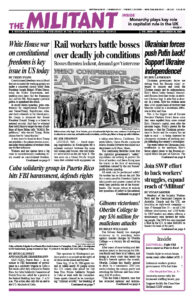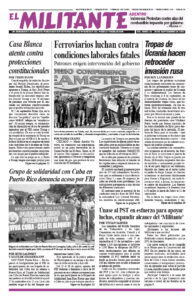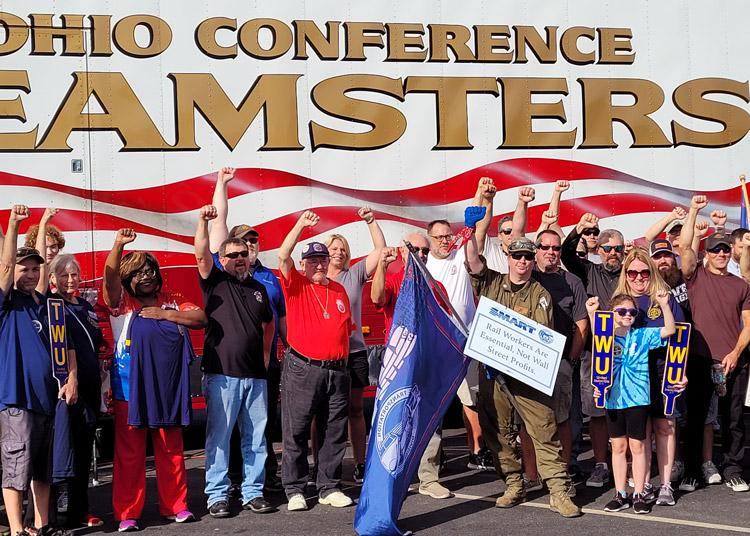LINCOLN, Neb. — Amid ongoing negotiations in Washington for a national contract between the main rail unions and bosses, two rail workers were killed on the job Sept. 8. The two were on a Union Pacific freight train that collided with equipment on a siding near Mecca, California. The week before, Union Pacific conductor Mario Aurelio Navarro was killed in a derailment in El Paso, Texas.
The continuing fatalities show that the capitalist government’s “safety” regulations do nothing to protect the lives of workers and those living near the tracks in the face of worsening conditions caused by the rail bosses’ profit-driven speedup.
All work can be performed safely! No worker has to die on the job! But this is only possible if workers fight to take greater and greater control of the work they perform out of the bosses’ hands. The bosses refuse to include key questions of safety in the national negotiations, including work schedules and crew size, insisting these are local issues.
The National Mediation Board, one of a number of government agencies that “regulate” relations between the rail unions and the bosses, ordered eight of the 12 rail unions and the owners of the larger national railroads — those that did not have a tentative agreement — back to Washington Sept. 7.
The Brotherhood of Maintenance of Way Employees — the largest of the track worker unions — announced Sept. 11 that it had reached an accord. That brings to 10 the rail craft unions that have tentative deals that need to be voted on by the membership.
In anticipation of a possible strike or lockout, the bosses at the largest railroads have begun placing embargoes on many new shipments. The tactic is aimed at pressuring Congress to intervene and order unionists back to work, like it did in the 1991 national strike and 1992 lockout.
Dennis Pierce, president of the Brotherhood of Locomotive Engineers and Trainmen, and Jeremy Ferguson, president of the Sheet Metal, Air, Rail and Transportation Workers-Transportation Division (SMART-TD), the largest of the unions that represent conductors and locomotive engineers, issued a joint statement Sept. 2 urging the U.S. Congress to stay on the sidelines because that would put more pressure on the bosses to reach an agreement favorable to the workers.
The inhumane schedules, attendance policies and crew sizes “have forced thousands of employees out of the industry and make it all but impossible to recruit new workers,” the statement said. “The railroads show no intentions of reaching an agreement with our unions.”
Living paycheck to paycheck
“Many members of my union who have families and live paycheck to paycheck are assigned to work seasonal ‘traveling steel’ gangs laying new track,” Rod Blessing, assistant local chair of Brotherhood of Maintenance and Way Employees Lodge 1320, told the Militant. He’s worked 24 years in rail trackage maintenance in Nebraska. “When they have to stay in hotels, they have to pay over $500 a week out of their own pocket. The company takes weeks to reimburse. Making the company pay for housing at check-in and not taking the cap off health insurance costs for workers are two of the factors that BMWE members want in the contract.”
The BMWE has led in organizing rallies to back workers’ demands since last May in Wyoming, Nebraska, Iowa and Illinois. Some 50 rail unionists and their supporters attended the most recent rally in Toledo, Ohio, Sept. 10. It was held in the parking lot of Teamsters Local 20’s union hall.
“The media concentrates on the 24% pay increase the Presidential Emergency Board recommended and says we’re still not satisfied. They ignore our important demands for sick days and to freeze health care costs,” said Matthew Weaver, Ohio BMWE organizer, who chaired the rally.
Under the contract proposal agreed to by BMWE officials — but still to be voted on by the membership — track workers will be reimbursed “promptly” for travel expenses. Workers will be responsible for 15% of the monthly premium the railroad bosses pay for health insurance. Each worker will get one additional paid day off per year.
Crew size and safety
The bosses are pushing hard for one-person train “crews,” but refuse to negotiate on this at a national level. Over the last decades the bosses have succeeded in cutting down crew sizes and increasing the length of trains. Five-person crews were standard in the 1970s. Today two-person crews are the norm.
Clyde Whitaker, SMART-TD Ohio state legislative director, told the rally about the dangers that having only one person, an engineer, on a train can have. The rail bosses propose having a conductor on call. If a rail crossing is blocked and medics are blocked from responding to an emergency or there is an accidental collision with a vehicle on the other side of the train, he said, “Who’s going to separate that train? Are you going to wait hours for a conductor to reach the scene?”
At the Sept. 10 rally about deteriorating conditions, Derek Deman, a carman at the Conrail yard in Detroit and member of Transport Workers Union Local 2051, told the Militant, “When I started 17 years ago, there were 55 car inspectors, today there are 25. The Federal Railroad Administration rules say that trains must be inspected every 1,000 miles but the railroad bosses want to increase inspections to 3,000 miles.”
In a show of solidarity, Tom Erickson, a vice president of the Teamsters in the central region, told the rally, “Rail workers deserve sick days and time with families and not be at the bosses’ beck and call 24/7.”
End of ‘cooling-off’ period
Worried that the main unions of train operators could go on strike Sept. 16, when a government-imposed “cooling off” period expires under the anti-union Railway Labor Act, President Joseph Biden’s administration has sent Labor Secretary Marty Walsh to the meetings being held by the National Mediation Board.
Biden showed his true colors when “administration officials,” the Washington Post reported Sept. 12, said they were worried that a strike could damage the economy, “as well as hurt Democrats in the upcoming midterm elections.”
The negotiations — and the possibility of a strike or lockout — are taking place as the freight railroad bosses are taking locomotives out of storage and reopening idled yards, as they seek to take advantage of increased shipping with the end of the pandemic.
The Association of American Railroads trade group issued a report Sept. 8, warning that a strike could idle some 7,000 freight trains a day and disrupt passenger operations nationwide. Amtrak and half of all commuter rail systems rely at least partly on tracks owned by the freight railroads. The disruption of deliveries and passenger traffic could cost businesses more than $2 billion a day, the report says.
The trade group says it would be impossible for trucks to pick up the slack because 467,000 additional trucks would be needed per day, and there is already a shortage of 80,000 drivers currently.
Ned Measel contributed to this article.


